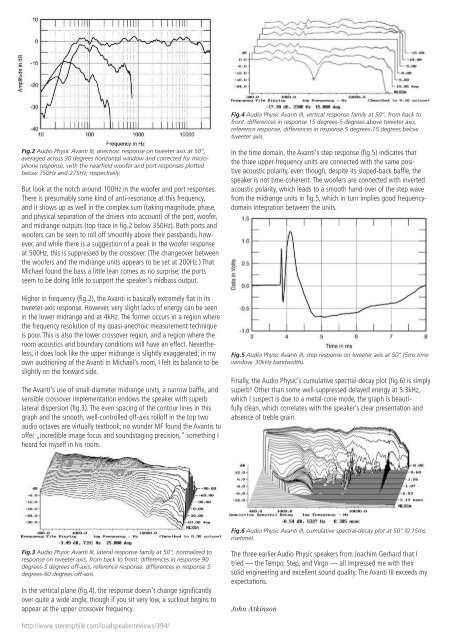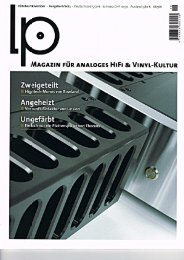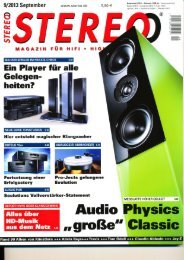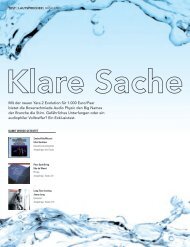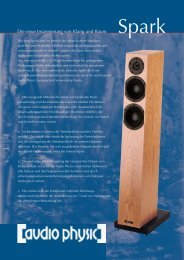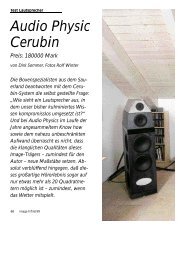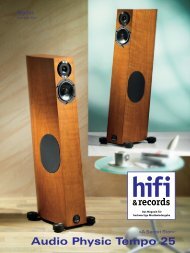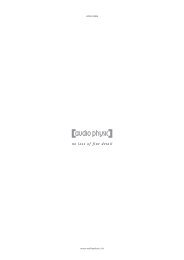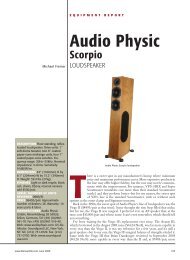Avanti III loudspeaker - Audio Physic
Avanti III loudspeaker - Audio Physic
Avanti III loudspeaker - Audio Physic
Create successful ePaper yourself
Turn your PDF publications into a flip-book with our unique Google optimized e-Paper software.
Fig.2 <strong>Audio</strong> <strong>Physic</strong> <strong>Avanti</strong> <strong>III</strong>, anechoic response on tweeter axis at 50“,<br />
averaged across 30 degrees horizontal window and corrected for microphone<br />
response, with the nearfield woofer and port responses plotted<br />
below 750Hz and 275Hz, respectively.<br />
But look at the notch around 100Hz in the woofer and port responses.<br />
There is presumably some kind of anti-resonance at this frequency,<br />
and it shows up as well in the complex sum (taking magnitude, phase,<br />
and physical separation of the drivers into account) of the port, woofer,<br />
and midrange outputs (top trace in fig.2 below 350Hz). Both ports and<br />
woofers can be seen to roll off smoothly above their passbands, however,<br />
and while there is a suggestion of a peak in the woofer response<br />
at 500Hz, this is suppressed by the crossover. (The changeover between<br />
the woofers and the midrange units appears to be set at 200Hz.) That<br />
Michael found the bass a little lean comes as no surprise; the ports<br />
seem to be doing little to support the speaker‘s midbass output.<br />
Higher in frequency (fig.2), the <strong>Avanti</strong> is basically extremely flat in its<br />
tweeter-axis response. However, very slight lacks of energy can be seen<br />
in the lower midrange and at 4kHz. The former occurs in a region where<br />
the frequency resolution of my quasi-anechoic measurement technique<br />
is poor. This is also the lower crossover region, and a region where the<br />
room acoustics and boundary conditions will have an effect. Nevertheless,<br />
it does look like the upper midrange is slightly exaggerated; in my<br />
own auditioning of the <strong>Avanti</strong> in Michael‘s room, I felt its balance to be<br />
slightly on the forward side.<br />
The <strong>Avanti</strong>‘s use of small-diameter midrange units, a narrow baffle, and<br />
sensible crossover implementation endows the speaker with superb<br />
lateral dispersion (fig.3). The even spacing of the contour lines in this<br />
graph and the smooth, well-controlled off-axis rolloff in the top two<br />
audio octaves are virtually textbook; no wonder MF found the <strong>Avanti</strong>s to<br />
offer „incredible image focus and soundstaging precision,“ something I<br />
heard for myself in his room.<br />
Fig.3 <strong>Audio</strong> <strong>Physic</strong> <strong>Avanti</strong> <strong>III</strong>, lateral response family at 50“, normalized to<br />
response on tweeter axis, from back to front: differences in response 90<br />
degrees-5 degrees off-axis, reference response, differences in response 5<br />
degrees-90 degrees off-axis.<br />
In the vertical plane (fig.4), the response doesn‘t change significantly<br />
over quite a wide angle, though if you sit very low, a suckout begins to<br />
appear at the upper crossover frequency.<br />
http://www.stereophile.com/<strong>loudspeaker</strong>reviews/394/<br />
Fig.4 <strong>Audio</strong> <strong>Physic</strong> <strong>Avanti</strong> <strong>III</strong>, vertical response family at 50“, from back to<br />
front: differences in response 15 degrees-5 degrees above tweeter axis,<br />
reference response, differences in response 5 degrees-15 degrees below<br />
tweeter axis.<br />
In the time domain, the <strong>Avanti</strong>‘s step response (fig.5) indicates that<br />
the three upper-frequency units are connected with the same positive<br />
acoustic polarity, even though, despite its sloped-back baffle, the<br />
speaker is not time-coherent. The woofers are connected with inverted<br />
acoustic polarity, which leads to a smooth hand-over of the step wave<br />
from the midrange units in fig.5, which in turn implies good frequencydomain<br />
integration between the units.<br />
Fig.5 <strong>Audio</strong> <strong>Physic</strong> <strong>Avanti</strong> <strong>III</strong>, step response on tweeter axis at 50“ (5ms time<br />
window, 30kHz bandwidth).<br />
Finally, the <strong>Audio</strong> <strong>Physic</strong>‘s cumulative spectral-decay plot (fig.6) is simply<br />
superb! Other than some well-suppressed delayed energy at 5.3kHz,<br />
which I suspect is due to a metal-cone mode, the graph is beautifully<br />
clean, which correlates with the speaker‘s clear presentation and<br />
absence of treble grain.<br />
Fig.6 <strong>Audio</strong> <strong>Physic</strong> <strong>Avanti</strong> <strong>III</strong>, cumulative spectral-decay plot at 50“ (0.15ms<br />
risetime).<br />
The three earlier <strong>Audio</strong> <strong>Physic</strong> speakers from Joachim Gerhard that I<br />
tried — the Tempo, Step, and Virgo — all impressed me with their<br />
solid engineering and excellent sound quality. The <strong>Avanti</strong> <strong>III</strong> exceeds my<br />
expectations.<br />
John Atkinson


